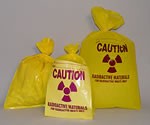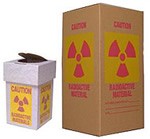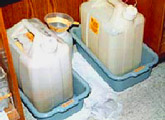How to Store and Dispose of Radioactive Waste
Read requirements for managing radioactive waste at UC San Diego.
Storage and disposal of radioactive waste is strictly regulated. All radioactive waste must be transferred to Environment, Health & Safety (EH&S) for disposal.
Do not dispose of radioactive waste in regular trash cans or pour it down drains.
Storage guidelines
- Separate all wastes by isotope and physical form.
- Note: EH&S considers uranium and thorium compounds such as nitrates and acetates to be radioactive. However, they should be contained separately from other radioactive wastes.
- Designate a specific location for the storage of radioactive waste.
- Post the area and label each collection container with a RADIOACTIVE warning symbol.
- Use appropriate shielding where applicable.
- Give special shielding consideration to high-activity or high-energy isotopes such as orthophosphate. Notify EH&S when generating this type of waste.
- Contact the EH&S Health Physicist assigned to your building for more information about shielding and signage.
- Attach a completed hazardous waste tag to each container in the radioactive waste storage area.
- Read How to Use Hazardous Waste Tags for details.
- Keep containers closed, except when material is being added. Make sure the container and bag exteriors are free of contamination.
- Request hazardous waste collection when you're ready for a waste pick up.
- Note: When you have high-activity or high-energy isotopes, note this in the "Other" field on the Request Hazardous Waste Collection form (if you're not using the Online Waste Tag Program), so the hazardous waste technician can bring appropriate shielding.
Animal waste
Bag carcasses, organs, tissues, and bedding in clear plastic bags.
- Wrap the waste in lab bench blankets before bagging whenever possible. Bench blankets provide extra absorbent material and keep claws from tearing through bags.
- Place a sufficient amount of absorbent material in the bag to absorb fluids that may leach from the waste.
- Free diatomaceous earth is available from EH&S for use as an absorbent. Request it using the online Hazardous Waste Collection Request form.
- See How to Request a Hazardous Waste Collection to access the form.
- Free diatomaceous earth is available from EH&S for use as an absorbent. Request it using the online Hazardous Waste Collection Request form.
- Place the bag in a second clear plastic bag, seal it, and make sure the exterior is free of contamination.
- Complete and attach a hazardous waste tag to the bag.
- List any additional chemical or biological hazards on the tag and the method of deactivation or disinfection used.
- Keep this waste cold or frozen until collected by EH&S.
- Request hazardous waste collection when you're ready for a waste pick up.
Dry waste

Yellow bags for dry iodine-contaminated waste

Boxes for collecting dry iodine-contaminated waste
Dry waste must be free of liquids and sharp objects that could puncture the waste bag.
- Package dry waste separately by isotope.
- Deface radioactive symbols and labels on dry waste if possible.
- Bag dry waste in clear plastic bags.
- Iodine-contaminated dry waste (I-131, I-125, and I-129) has special requirements: Line a radioactive waste box with a yellow radioactive waste bag for collecting iodine-contaminated dry waste. (See images above.)
- Yellow bags are available from Marketplace in 2 sizes:
- 24” x 36”, Part #7825
- 18” x 24”, Part #7826
- Boxes are available from Marketplace in 2 sizes:
- 12” x 12” x 24”, Part #7827
- 8” x 8” x 10”, Part #7828
- Yellow bags are available from Marketplace in 2 sizes:
- Iodine-contaminated dry waste (I-131, I-125, and I-129) has special requirements: Line a radioactive waste box with a yellow radioactive waste bag for collecting iodine-contaminated dry waste. (See images above.)
- Attach a completed hazardous waste tag.
- Seal the plastic bag when it's full and move it to the radioactive waste storage area. Seal it in a second clear plastic bag.
- Request hazardous waste collection when you're ready for a waste pick up.
Gels
EH&S provides and replaces 5-gallon bucket containers for collection of agarose gels used for electrophoresis.
- Request buckets using the Hazardous Waste Collection form. (See How to Request a Hazardous Waste Collection to access the form.)
- In the "Other" field at the bottom of the form, specify the number of buckets needed.
- Other small, leak-proof containers are acceptable, but EH&S will not return these containers to the lab.
- Store only gel waste in the container.
- Line the container with 2 clear plastic bags.
- When the container is 3/4 full, seal the plastic bags. Tie off the second bag and screw the lid on the container.
- Complete and attach a hazardous waste tag to the container, estimating activity as accurately as possible.
- Place the container in the radioactive waste storage area of the lab.
- Request hazardous waste collection when you're ready for a waste pick up.
Liquid waste
|
|
 Small carboy |

Carboys in secondary containers
Do not fill liquid waste containers past the "Max Fill" line. EH&S cannot collect over-filled containers.
- Always store liquids within a secondary container. Secondary containers must be large enough to hold all of the liquid in the primary container plus 10%.
- Carboys are for liquids only. Do not put solid objects such as pipettes or pipette tips, microcentrifuge tubes, or wipes in carboys.
- Separate liquids by isotope whenever possible. Separate aqueous from non-aqueous liquids whenever possible.
- Complete and attach a hazardous waste tag to the container when the first drop of waste is added. Include the following information:
- List 100% of the liquid composition.
- List the concentrations of the waste when mixed.
- Never use abbreviations or chemical formulas.
- Store full containers in the radioactive waste storage area of the lab. Request hazardous waste collection when you're ready for a waste pick up.
- Obtain containers for liquid radioactive wastes from EH&S.
- EH&S automatically delivers replacement containers at the time of waste pickup.
- If you need to order additional containers, note this in the "Other" field at the bottom of a Request Hazardous Waste Collection form. (See How to Request a Hazardous Waste Collection to access the form.)
- In the "Other" field at the end of the form, specify the size you want:
- Standard large carboys hold five gallons (19 liters).
- Small "Nalgene" carboys hold 2 gallons (7.5 liters).
- In the "Other" field at the end of the form, specify the size you want:
Liquid scintillation vials
Use biodegradable scintillation cocktails whenever possible.
- Place used scintillation vials into flats.
- EH&S periodically has free empty vial flats available. Request flats using the Hazardous Waste Collection form. (See How to Request a Hazardous Waste Collection to access the form.)
-
In the “Other” field at the end of the form, specify the vial size you want (large 20 milliliters or small eight milliliters) and the number of flats needed. Separate plastic and glass vials.
-
- EH&S periodically has free empty vial flats available. Request flats using the Hazardous Waste Collection form. (See How to Request a Hazardous Waste Collection to access the form.)
- You may double-bag small quantities of vials if they are tightly capped and in a secondary container. Use clear plastic bags.
- Complete and attach a hazardous waste tag to the container.
- Specify the brand name of scintillation cocktail used.
- List all suspected isotopes in vials from wipe tests or dual-labeled samples.
- Store used vials in the radioactive waste storage area of the lab.
- Request hazardous waste collection when you're ready for a waste
pick up.
Mixed chemical-radioactive waste
Select a storage container made of material compatible with the chemical it will hold.
- Complete and attach a hazardous waste tag to the bag or container. Include the following information:
- All chemical constituents and their percentages.
- Concentrations of the different chemicals in the waste (abbreviations and chemical formulas are not acceptable.)
- Store the container in the radioactive waste storage area of the lab.
- If liquid waste, store in secondary containers provided by EH&S. See the guidelines for liquid radioactive waste above.
- Request hazardous waste collection when you're ready for a waste pick up.
Mixed infectious-radioactive waste
Decontaminate infectious waste at the source of generation whenever possible. Contact EH&S Biosafety for approved methods of decontamination.
- Keep infectious radioactive waste separate from other waste.
- Package the waste per the appropriate waste category described in the steps above (dry, liquid, sharps, gels, etc.).
- Add absorbent material to the second bag, sufficient to absorb fluids which may leach from the waste.
- Seal the outer bag and make sure it's free of contamination.
- Complete and attach a hazardous waste tag to the bag. Include the following information:
- List all hazardous constituents (chemical, infectious)
- Indicate that the bag contains infectious waste and the decontamination method used.
- Request hazardous waste collection when you're ready for a waste pick up.
Sharps and broken glass

Sharps container
Examples of sharps include pipettes, pipette tips, syringes, blades, and broken glass – solid waste that's capable of puncturing or tearing a plastic bag.
Sharps may also be contaminated with chemicals or infectious agents, but must be handled first as radioactive waste.
- Deactivate any infectious agents.
Caution: Some isotopes may react with certain deactivation chemicals. For example, you don't want to bleach isotopes of iodine.- Contact EH&S Biosafety for assistance with deactivation.
- Collect sharps and broken glass in rigid, leak-proof, puncture-resistant sharps containers to protect waste handlers and maintenance personnel from injury.
- Containers sold on Marketplace fit most needs.
- With the exception of needles, which must be placed in a sharps container, you can also use a rigid cardboard box, lined with a clear plastic bag.
- Label the container with a hazardous waste tag. Remove or deface any other labels or biohazard symbols on the container.
- Include all of the following information on the tag :
- The isotope used
- Any additional chemicals or biological hazards
- The method of deactivation or disinfection used, if any
- Mark the waste type as "other" and write SHARPS on the tag.
- Do not place free liquids, such as full syringes, in sharps containers.
- Store the container near where the waste is generated until it is full. When the container is full, seal it and move it to the lab's designated radioactive waste storage area. Request a hazardous waste collection when the sharps container is full.
